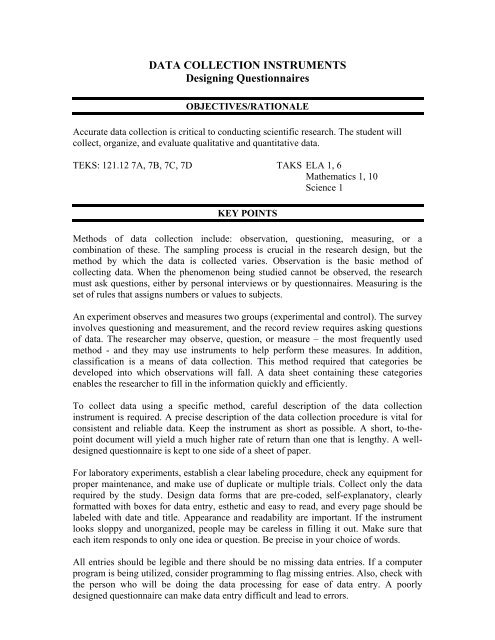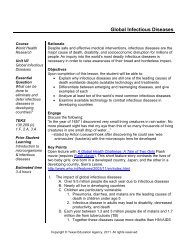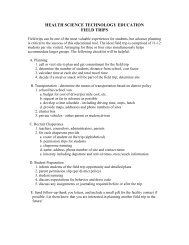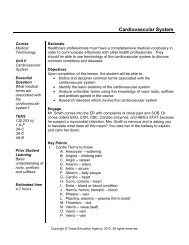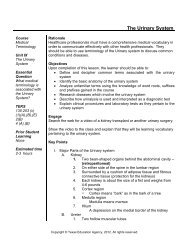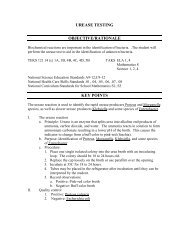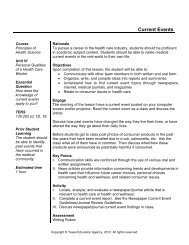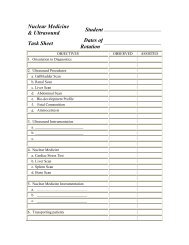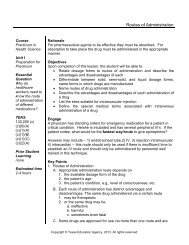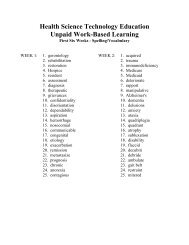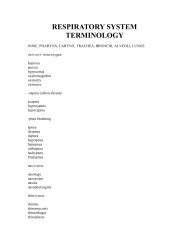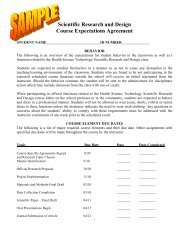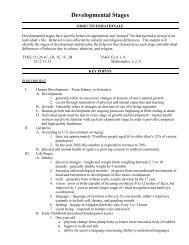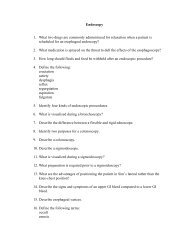DATA COLLECTION INSTRUMENTS Designing ...
DATA COLLECTION INSTRUMENTS Designing ...
DATA COLLECTION INSTRUMENTS Designing ...
Create successful ePaper yourself
Turn your PDF publications into a flip-book with our unique Google optimized e-Paper software.
<strong>DATA</strong> <strong>COLLECTION</strong> <strong>INSTRUMENTS</strong><strong>Designing</strong> QuestionnairesOBJECTIVES/RATIONALEAccurate data collection is critical to conducting scientific research. The student willcollect, organize, and evaluate qualitative and quantitative data.TEKS: 121.12 7A, 7B, 7C, 7D TAKS ELA 1, 6Mathematics 1, 10Science 1KEY POINTSMethods of data collection include: observation, questioning, measuring, or acombination of these. The sampling process is crucial in the research design, but themethod by which the data is collected varies. Observation is the basic method ofcollecting data. When the phenomenon being studied cannot be observed, the researchmust ask questions, either by personal interviews or by questionnaires. Measuring is theset of rules that assigns numbers or values to subjects.An experiment observes and measures two groups (experimental and control). The surveyinvolves questioning and measurement, and the record review requires asking questionsof data. The researcher may observe, question, or measure – the most frequently usedmethod - and they may use instruments to help perform these measures. In addition,classification is a means of data collection. This method required that categories bedeveloped into which observations will fall. A data sheet containing these categoriesenables the researcher to fill in the information quickly and efficiently.To collect data using a specific method, careful description of the data collectioninstrument is required. A precise description of the data collection procedure is vital forconsistent and reliable data. Keep the instrument as short as possible. A short, to-thepointdocument will yield a much higher rate of return than one that is lengthy. A welldesignedquestionnaire is kept to one side of a sheet of paper.For laboratory experiments, establish a clear labeling procedure, check any equipment forproper maintenance, and make use of duplicate or multiple trials. Collect only the datarequired by the study. Design data forms that are pre-coded, self-explanatory, clearlyformatted with boxes for data entry, esthetic and easy to read, and every page should belabeled with date and title. Appearance and readability are important. If the instrumentlooks sloppy and unorganized, people may be careless in filling it out. Make sure thateach item responds to only one idea or question. Be precise in your choice of words.All entries should be legible and there should be no missing data entries. If a computerprogram is being utilized, consider programming to flag missing entries. Also, check withthe person who will be doing the data processing for ease of data entry. A poorlydesigned questionnaire can make data entry difficult and lead to errors.
Always give a due date. Asking for the form “as soon as possible” may result in younever receiving it! Make sure the subjects know how, when, and where to return yourquestionnaire.Once the data collection phase is completed, the phase of data analysis and interpretationbegins.DESIGNING A QUESTIONNAIREQuestionnaires are utilized by all areas of the healthcare industry. If designed properly,they are considered to be scientific measuring instruments. It is important to carefullythink through the purpose of the research before rushing into the field with aquestionnaire. Your questionnaire should be more than a mere inventory of what youwould like to know. Consideration must be given to some of the problems involved inwhat you hope to get and to the best method of gathering that information.In the laboratory, instruments used for measuring are thoroughly tested before beingutilized. Likewise, a good questionnaire should be tested prior to using in the field. Thereare four items to consider before designing a questionnaire:1)Hypothesis: What hypothesis is being tested?Can the Hypothesis be tested by the questions being asked?2)Sample: What is the population from which the sample will be taken?Sample selection is a critical stage of planning your study. The questionnaireshould be appropriate for the subjects being studied.3)Questions: What kind and how many questions should be asked?Questions should be concise - without ambiguities.4)Administration: How will the instrument be administered?A. Yes-No….This simplifies tabulation, but does not give the subjecta wide range of choice. Adding a maybe or do notunderstand choice may be appropriate here.B. Multiple Choice….This allows for some scaling of answer choices.However, it is difficult to include all possible responses aschoices.Example: How many times have you seen the patient forthis problem in the last year?____None ____1-4 times ____more than 4 timesAlso, beware of the pitfall of “leading” your targetpopulation in a certain direction by the way you state aquestion.C. Numerical Answers/Likert Scale….Provides a range ofresponses, usually 1 to 4 or 5, indicating “stronglydisagree” to “strongly agree”. Variables that are measureson a continuous scale, like weight, should be obtained inthe measured units. Be sure to specify units you desire. Ifnecessary, the measurements can be grouped later.
Example: What is your current weight? _____lbs.D. Open-ended….The subjects are expected to answer using theirown language. You may receive a wide range of responses.These questions are time-consuming and very difficult toanalyze. They can yield valuable information but in mostcases, should be limited to two or three.Administering a QuestionnaireWhen mailing a questionnaire:1. Include a cover letter that gives an unthreatening appeal for cooperation.2. Enclose a stamped, self-addressed envelope or email address.3. Devise a method for identifying non-respondents. People are often afraidto be identified. So don’t ask for any information that would single themout of the group (such as name). Use color coding of forms for variousgroups. For example-student’s forms are green and teacher’s forms areblue.Interviewers administering a questionnaire must:1. Be trained and must employ the same techniques.2. Be presentable and unthreatening.3. Adhere to the questions and written statements explaining difficultquestions.Pre-testing the Questionnaire1. The pre-test group should be a random sample from the population you are goingto study.2. The pre-test should match the final test. Consider it a dress rehearsal!3. The results of the pre-test can be used to determine whether the subjectsunderstand each question. You may be amazed to find out that what was clear toyou is confusing to someone else. This will help you to identify and correctpossible problems before your document is utilized for data collection.Sources of ErrorSampling Error – error that occurs because data was gathered from only the responsiveportion of the population.Conceptual Error – error due to survey instrument design and/or specifications, such astarget population not clearly defined and therefore sample is not representative ofdesired target population.Non-response Error – error due to not covering, lack of respondent cooperation or recall,collecting agent omission, illegible responses, or lost records.Measurement Process Error – badly worded questions, poor interviewer who influencesthe responses of the subject.Processing and Analysis Error – coding error, computation error, presentation error, orinterpretation error.
ACTIVITIESStudents will collect questionnaires from various sources to share with the class.The class will then discuss and critique the questionnaires for design, method ofadministration, and possible sources of error.Questionnaires from various sourcesMATERIALSClass Participation RubricASSESSMENT


